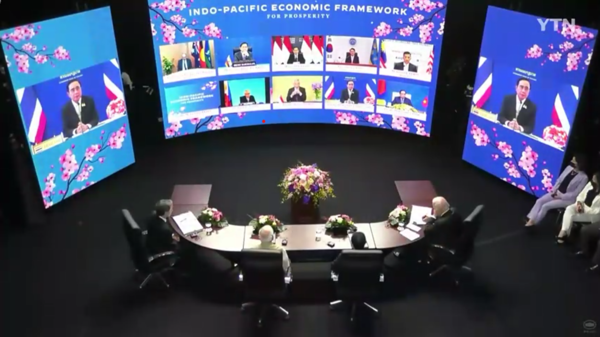This article was originally published on Yonhap News and translated by OKN Correspondent.
The US-led Indo-Pacific Economic Framework (IPEF), a multilateral economic cooperation initiative, was officially launched on the 23rd to curb China’s economic influence.
US President Joe Biden presided over the ‘Indo-Pacific Economic Framework for Prosperity’ launch event in Tokyo, Japan, on the afternoon of the second day of his visit to Japan and announced the official launch.
With this, the Biden administration has formalized its intention to press China in all directions not only in security and military fields but also through establishing alliances and an ‘economic encirclement’ in the Indo-Pacific region.
The IPEF is a “counterattack” from the US in response to China’s “Regional Comprehensive Economic Partnership (RCEP) Agreement,” the world’s largest free trade agreement, to expand Chinese economic territory in the Indo-Pacific region.
Since China has reacted sensitively to the US’ move to form the IPEF, the announcement today is expected to intensify the uncomfortable tension between the US and China.
The launch announcement is the result of seven months after President Biden virtually attended the East Asia Summit (EAS) in October of last year and revealed his intention to push the IPEF.
In his press briefing, White House National Security Adviser Jake Sullivan said that 13 countries from the Indo-Pacific region would participate in the IPEF.
First of all, Japan, Australia, New Zealand, and India have listed along with the United States and South Korea.
Seven countries from the Association of Southeast Asian Nations (ASEAN), including Brunei, Indonesia, Malaysia, the Philippines, Singapore, Thailand, and Vietnam, also participated. The number is higher than initially expected, in that ASEAN will hesitate to join, being conscious of its relationship with China.
President Yoon Suk Yeol attended the event virtually.
In particular, the participation of India is noteworthy, which has the second-largest population in the world and has complicated geopolitical and economic interests with China. Initially, India’s participation was not highly expected.
Among ASEAN countries, Myanmar, which had conflicting relations with the United States after a military coup d’état took power, and Laos and Cambodia, were omitted. Taiwan, which has expressed its intention to join, was also excluded from the list.
US Secretary of Commerce Gina Lamondo said the IPEF member states account for 40% of the world’s combined gross domestic product (GDP), and the IPEF includes some of the world’s fastest-growing and most dynamic countries.
The IPEF does not include market access, such as tariff cuts, vital to existing general trade agreements. Instead, the IPEF is different from other agreements in that it focuses on the four policy pillars, such as global trade, supply chain, decarbonization and infrastructure, and tax and anti-corruption.
The United States will shortly convene a ministerial summit to further scope the IPEF operation method and agenda for each policy pillar.
It is expected that the US will seek to set standards and cooperation plans for each pillar under the “rules-based international order.” The US will focus on containing China, such as targeting China’s trade and economic practices that have been criticized for being coercive.
In particular, the goal of the US is to exclude China from key sectors such as semiconductors and batteries and establish a regional supply chain. President Biden’s important visits to Samsung Electronics and Hyundai Motors can be understood in the same context.
Such fields are industries where South Korea is strong and competes with China; thus, depending on the progress of the negotiations, it can affect South Korea as well.
“The launch of the IPEF would mark a significant turning point in restoring US economic leadership in the Indo-Pacific and providing an alternative to China’s approach.” said Secretary Lamondo.
However, strong opposition from China, which exerts a strong influence in the Indo-Pacific, is expected. Some criticize the lack of incentives, such as tariff cuts to actively entice ASEAN .
In addition, there are many hurdles to overcome in the future, such as what should be included in the IPEF and how to negotiate the keen interests of each country as it is still at the initial level with the four major pillars.
U.S. Trade Representative Katherine Tai said that “countries will be discussing it over the next few weeks and months to shape what they will commit to and sign.”


